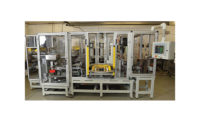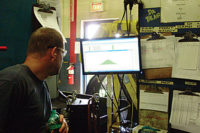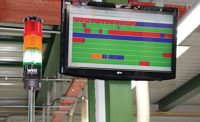This past May, automotive modules and components manufacturer TRW was purchased by transmission manufacturer ZF for $12.4 billion. The deal creates ZF-TRW—the world’s third-largest auto supplier, with 130,000 employees and annual sales of more than $34.2 billion.
However, most TRW plants continue to operate as they did before the merger. This includes having to deal with several ongoing challenges, such as preventing downtime and optimizing machine capacity.
Both were major problems at the TRW facility in Blumberg, Germany, until five years ago. Opened in 1945, the plant produces valves of all shapes and sizes, and employs more than 850 people.
“There was a lack of transparency of production as the site continued to expand,” explains Bernd Müller, manufacturing development engineer for ZF-TRW. “Over a number of years, it became increasingly difficult to maintain an overview of machine status. Another problem was the diversity of process controls being employed.”
At the beginning of 2010, Müller began researching wireless systems to more effectively monitor the plant’s many assembly machines. Wire systems weren’t a practical option because they involved laying cables throughout the plant’s extensive and older infrastructure.
Within a short time, Müller discovered the WIN (wireless information network) machine data collection system made by WERMA Signaltechnik. It consists of three preconfigured signal towers and WIN slaves, a WIN master device, a USB cable and PC software with an easy-to-use menu.
Each signal tower has LED lights in red, yellow and green. A slave is placed beneath the tower, which is covered in a tube that mounts easily onto a machine. The maser device, equipped with a small antenna, is positioned on the wall or next to the PC and connected via the USB cable. Data is continuously transmitted from one or more signal towers (and machines) to the master device.
Initially, TRW used the system to monitor 10 critical machines. According to Müller, the plug-and-play system installed easily, was running immediately and provided a precise overview of all the machines’ status in a matter of minutes.
Because of this, the system quickly met all of TRW’s expectations in terms of eliminating downtime. Equally important, the system helps managers quickly locate and correct production errors and interruptions to improve efficiency and eliminate waste.
Elmar Giner, a database expert in the IT department at TRW, likes that the system software continually displays the network’s signal strength between machines. With this information, line managers can note potential weak spots in the network that may have to be reinforced to ensure effective wireless monitoring. He also likes the simple root and branch structure of the network, enabling it to be installed by people with no programming knowledge.
TRW has continually expanded its WIN system at the Blumberg facility, and currently uses it to monitor 80 machines. Data obtained by the system is displayed on five very large plasma screens located throughout the plant. Members of the service, electrical and mechanical maintenance departments rely on these screens to learn of any production problems and reply promptly.
Complementing the screens is the system’s email notification service. When a problem arises for a specific machine, a message is automatically sent to the responsible manager or managers via their local PCs or smart phones.
Müller says real-time production and scrap data obtained by the system also help TRW implement lean manufacturing. Such data helps him more accurately determine why and how often downtime occurs, and then develop countermeasures to improve productivity.
For more information on machine data collection systems, call 315-414-0200 or visit www.werma.com.





